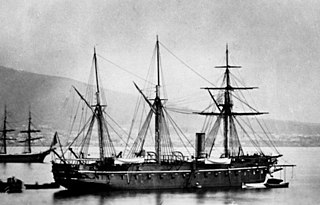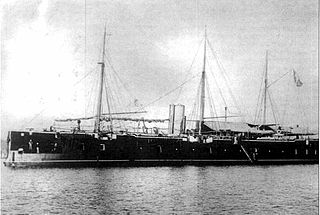Related Research Articles

Affondatore was an armoured ram of the Regia Marina, built in the 1860s by Harrison, Millwall, London. Construction commenced in 1863; the ship, despite being incomplete, was brought to Italy during the Third Italian War of Independence. Affondatore, which translates as "Sinker", was initially designed to rely on her ram as her only weapon, but during construction she was also equipped with two 300-pounder guns.

Cristoforo Colombo was a steel-hulled corvette built in the early 1890s for the Italian Regia Marina. The ship was built as a replacement for an earlier vessel of the same name, based on a nearly identical design. The new ship was intended to serve in Italy's colonial empire in eastern Africa, and was designed to be able to operate at long range, far from home ports, for an extended period of time.

Vettor Pisani was a screw corvette of the Italian Regia Marina built in the late 1860s and early 1870s. The ship left Italy in 1882 for a three-year voyage round the world.

SMS Kaiser was a 92-gun wooden ship of the line of the Austrian Navy, the last vessel of the type, and the only screw-driven example, to be built by the Austrians. She was built by the naval shipyard in Pola; she was laid down in March 1855, was launched in October 1858, and was completed the following year. The ship took part in the Second Schleswig War of 1864, but saw no action during her deployment to the North Sea. Kaiser did see action during the Seven Weeks' War two years later, during which she took part in the Battle of Lissa as the flagship of Anton von Petz, commander of the Austrian 2nd Division. Kaiser engaged several Italian ironclads simultaneously, rammed one—Re di Portogallo—and damaged another—Affondatore—with gunfire. In doing so, she became the only wooden ship of the line to engage an ironclad warship in battle.

Roma was an ironclad warship built for the Italian Regia Marina in the 1860s; she was the lead ship of the Roma-class ironclads. Armed with a main battery of five 254 mm (10 in) and twelve 203 mm (8 in) guns in a broadside arrangement, Roma was obsolescent by the time she entered service. As a result, her career was limited. In 1880, she took part in an international naval demonstration off Ragusa to enforce the Treaty of Berlin. In November 1881, she collided with the ironclad Principe Amedeo in a storm in Naples, but she was not damaged. Roma was reduced to a guard ship in 1890 and then to a depot ship in 1895. In July 1896, she was scuttled to save the ship from a fire caused by a lightning strike. She was thereafter raised and broken up for scrap.

Venezia was the second of two Roma-class ironclad warships built for the Italian Regia Marina in the 1860s. She was armed with a main battery of eighteen 254 mm (10 in) guns in a central armored casemate. Her lengthy construction time, a result of her re-design from a broadside ironclad, quickly rendered her obsolescent compared to the new turret ships that began to enter service in the 1880s. As a result, her career was limited. She became a training ship in 1881 and served until 1895. Venezia was broken up for scrap the next year.

San Martino was a Regina Maria Pia-class ironclad warship, the second member of her class. She was built for the Italian Regia Marina in the 1860s; like her three sister ships, she was built in France. San Martino was laid down in July 1862, was launched in September 1863, and was completed in November 1864. The ships were broadside ironclads, mounting a battery of four 203 mm (8 in) and twenty-two 164 mm (6.5 in) guns on the broadside.

Castelfidardo was the third of four Regina Maria Pia-class ironclad warships built in French shipyards for the Italian Regia Marina in the 1860s. Castelfidardo was laid down in July 1862, was launched in August 1863, and was completed in May 1864. She and her three sister ships were broadside ironclads, mounting a battery of four 203 mm (8 in) and twenty-two 164 mm (6.5 in) guns on the broadside.

Messina was the second of three Principe di Carignano-class ironclads built for the Italian Regia Marina in the 1860s. She was laid down in September 1861, her hull was launched in December 1864, and she was completed in February 1867. Messina was a broadside ironclad armed with a battery of four 203 mm (8 in) guns and eighteen 164 mm (6.5 in) guns. Her career was limited, owing to the emergence of more modern ironclads and a severe reduction in the Italian naval budget following their defeat at the Battle of Lissa in 1866. She was discarded in 1875 and sold to ship breakers to help pay for new ironclads then under construction.

Conte Verde was the third of three Principe di Carignano-class ironclads built for the Italian Regia Marina, though she differed in several respects from her sisters. Unlike the other two members of her class, she did not receive complete iron armor, instead relying on partial plating at her bow and stern. She was laid down in February 1863, she was launched in July 1867, and she was completed in December 1871. Conte Verde was a broadside ironclad armed with a battery of four 203 mm (8 in) guns and eighteen 164 mm (6.5 in) guns. Her career was limited, owing to the emergence of more modern ironclads and a severe reduction in the Italian naval budget following their defeat at the Battle of Lissa in 1866. She was discarded in 1880 and sold to ship breakers to help pay for new ironclads then under construction.

Terribile was the first ironclad warship to be built for the Italian Regia Marina, and the second member of the Formidabile class. Terribile and her sister, Formidabile, were both built in France. A broadside ironclad, she was laid down in June 1860, launched in February 1861, and was completed in September that year. She was the first Italian ironclad to enter service and was equipped with four 203 mm (8 in) and sixteen 164 mm (6.5 in) guns.

Formidabile was the lead ship of the Formidabile-class ironclad warships, the first ships of that type to be built for the newly formed Italian Regia Marina. Formidabile and her sister, Terribile, were both built in France; Formidabile was laid down in December 1860, was launched in October 1861, and was completed in May 1862. She was a broadside ironclad, equipped with four 203 mm (8 in) and sixteen 164 mm (6.5 in) guns.

The Principe di Carignano class was a group of three ironclad warships built for the Italian Regia Marina in the 1860s. The class comprised the ships Principe di Carignano, Messina, and Conte Verde. Originally ordered as wooden frigates, they were the first ironclads to be built in Italy, but the inexperience of the Italian shipyards and the redesign process produced lengthy construction times, such that only the lead ship was completed in time to see action during the Third Italian War of Independence in 1866. The first two ships were protected by a complete belt of wrought iron plating that was 121 mm (4.75 in) thick, while Conte Verde only received a partial iron belt.

The Formidabile class was a pair of ironclad warships built for the Italian Regia Marina in the 1860s. The class comprised two ships, Formidabile and Terribile. Initially ordered for the Regia Marina Sarda, by the time they were completed the Kingdom of Sardinia had unified the rest of the Italian states and created the Regia Marina. They were the first ironclads built for the Italian fleet. Wooden-hulled vessels plated with 4.3 inches (109 mm) of wrought iron, they were armed with a battery of twenty guns in a broadside arrangement.

Cristoforo Colombo was a screw corvette of the Italian Regia Marina built in the 1870s.

Caracciolo was a screw corvette of the Italian Regia Marina built in the 1860s. She was the first vessel of that type built after the unification of Italy, though the Italian fleet inherited several screw corvettes from the navies of Naples, Tuscany, and Sardinia. The ship was armed with a main battery of six 160 mm (6.3 in) guns. Originally built with both steam and sail propulsion, Caracciolo later had her engine removed for use as a training ship.

San Giovanni was a sail corvette built for the Royal Sardinian Navy in the late 1840s. In 1861, she was converted into a screw corvette by which time the unification of Italy had been largely completed. As a result, she served with the Italian Regia Marina when the work on the ship was finished. She was present for the Battle of Lissa in 1866 during the Third Italian War of Independence, though she did not engage the Austrian Navy in the battle. She was eventually laid up in 1875 and broken up for scrap in 1878.

Magenta was a screw corvette, originally of the Tuscan Navy, which was later incorporated into the Italian Regia Marina during the unification of Italy. The ship was built in the late 1850s and early 1860s; by the time she was completed, Italy had unified and so she only served in the Regia Marina. She made a circumnavigation of the globe, which lasted from 1865 to 1868, making her the first Italian vessel to do so. The voyage included diplomatic missions to China and Japan, along with scientific explorations and surveys. She saw little service thereafter, and was laid up in 1875 and broken up that same year.

Etna was a screw corvette of the Italian Regia Marina, originally ordered by the Real Marina of the Kingdom of the Two Sicilies, but completed after the unification of Italy. The ship had a relatively uneventful career, primarily cruising in the Mediterranean Sea in the 1860s, although she also made a deployment to South America from 1869 to 1871. She was laid up in 1875, but her ultimate fate is unknown.
References
- "Bewegungen S. M. Kriegsschiffe vom 1. September 1873 bis 31. August 1874" [Movements of S. M. Warships from 1 September 1873 to 31 August 1874]. Jahrbuch der Kais. Kön. Kriegsmarine[Yearbook of the Imperial and Royal Navy]. Pola: Verlag der Redaction: 15–26. 1874.
- Camera dei Deputati: Relazione della Commissione General del Bilancio [Chamber of Deputies: Report of the General Budget Committee] (in Italian). 1875.
- Cresciani, Gianfranco (2003). The Italians in Australia. Cambridge: Cambridge University Press. ISBN 978-0-521-53778-0.
- Dupont, Paul, ed. (1872). "Notes sur La Marine Et Les Ports Militaires de L'Italie" [Notes on the Navy and Military Ports of Italy]. La Revue Maritime et Coloniale[The Naval and Colonial Review] (in French). XXXII. Paris: Imprimerie Administrative de Paul Dupont: 415–430.
- Fraccaroli, Aldo (1979). "Italy". In Gardiner, Robert (ed.). Conway's All the World's Fighting Ships 1860–1905 . London: Conway Maritime Press. pp. 334–359. ISBN 978-0-85177-133-5.
- Guerrini, Domenico (1908). Lissa (1866): Come Arrivammo a Lissa[Lissa (1866): How We Came to Lissa] (in Italian). Torino: Libreria Editrice Di F. Casanova & Cia.
- "Principessa Clotilde: Corvetta ad elica di II ordine" [Principessa Clotilde: 2nd Rank Screw Corvette]. marina.difesa.it (in Italian). Retrieved 21 December 2023.